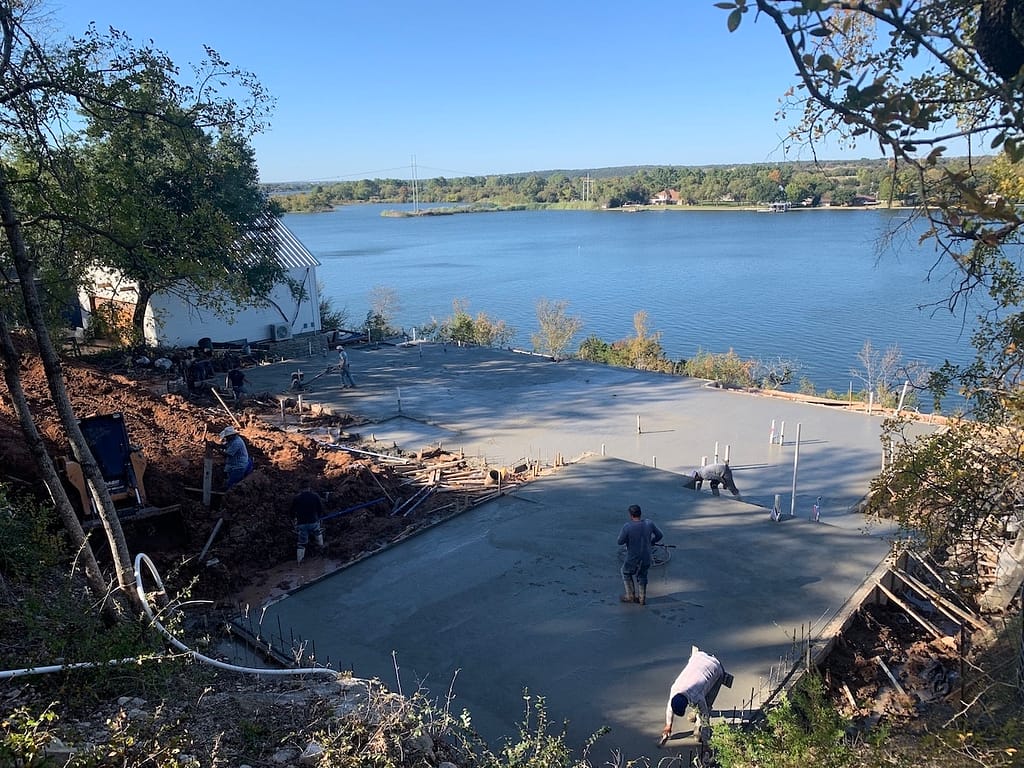Intricacies, Challenges and Best Practices

Foundation repair costs each year across the United States are more than the combined damage from tornadoes, hurricanes, earthquakes, and floods. Insurance companies know this and typically exclude coverage for foundation distress resulting from moisture-sensitive soil movements.
We provide this annual article as a review of best practices for builders. But its primarily serves as a resource to help builders explain the process of foundation building to your clients. Keep in mind that many people you serve may be new Texas residents. Many are unfamiliar with the most common types of foundations used in Texas. Communication is essential. And when it comes to foundations, it’s important to convey that even solidly built homes can have problems.
Soil and weather conditions that cause the most common foundation problems and are hard to predict and control. Soil moisture can increase from landscape watering, poor grading, drainage and utility leaks. All are common occurrences and are hard to control. A decrease in soil moisture due to excessive evaporation is also hard to control and just as problematic. Builders, take care to explain your process for predicting and mitigating potential problems. And be sure to explain your home warranty program in detail.
Keep in mind: All roads are dirt roads and foundations of homes work the same way.
It doesn’t matter whether you paint the surface with asphalt or concrete. Roads are still supported and made primarily of dirt! The slab foundations used for most homes built in Texas work the same way. They are all supported by the soil underneath—or at least they are supposed to be!
Expansive clays, compressible and collapsible soils and inadequately compacted fill are challenges we continually battle. Moisture in these soils can cause heave, settlement, and shrinkage. Dry soil caused by drought conditions is an enemy, too.
An engineered foundation is your best defense against structural defects. The definition of an engineered slab is one which is based on geotechnical engineering information and the design of the foundation is performed by a licensed engineer. It also requires that construction is observed with written documentation.


The first step in planning for construction is a soil analysis.
Once the floorplan is finalized, the design team’s most important task is to stabilize the soil and plan the foundation and structure of the home. Savvy builders work with a person or team whose scope of expertise encompasses civil engineering, forensic geotechnical engineering and specialized structural engineering.
A soil analysis is an essential first step in engineering the slab. When land lots are developed, the lot’s highs and lows are filled to provide a level surface for the home. As a result, some of the various layers of soil end up closer to the surface than others. Each of them can conduct water differently. The result is a dynamic, constantly changing soil system. Soils with different bearing capacity across the area of the slab are a common issue sure to cause problems. For this reason and others, the soils on neighboring sites can vary, so it’s wise to test every site individually.
When field and lab testing are completed, the engineering team will address any areas with soft or loose soil. Some areas may need to be excavated and filled with a more stable material. It has become a common practice in Texas for engineers to recommend injecting problem soils with environmentally safe chemical soil stabilizers to change their electrochemical nature. The goal is to inhibit the soil’s ability to associate with water, thereby minimizing the soils’ basic swell/shrink characteristics and increasing the compressive strength and support value.
Each project requires a site-specific foundation design.
A good engineer’s goal should be to design the foundation heavy enough when warranted, and light enough where site conditions allow. A foundation should be neither over- or under-designed.
Most foundations used in Texas are slab-on-ground. The engineering team will most often specify a post-tensioned (cable) slab-on-ground. Other options might include a steel reinforced (rebar) slab-on-ground, or barrier beam (deep perimeter) design. Alternatively, the engineer may specify foundation piers to get to the bedrock or stiffer more solid soil below.
Pier and beam foundations are another option, but they are much less common in Texas. Basement foundations are even more of a rarity since the frost line in Texas is pretty much nonexistent and thus a deeply dug home foundation is not required. Both of the latter and less common foundation alternatives can have certain advantages, but also just as many disadvantages.
In Texas, we have more cooling days than heating days in a year. Our “cooling” climate that allows us to benefit from an un-insulated slab is another reason that slab foundations are more common. The cool temperature of the ground actually reduces heat load requirements of the air conditioning unit. The only insulation you will need to keep your home cool in the summer and warm in the winter is installed in the walls, ceiling, and attic of your home.
Prepping the site with proper grading to prevent erosion and address drainage is next.

Grading and compacting the soil to the required density comes next. Experts recommend that ideally the ground should drop one inch for every one foot that you move away from the house for the first 5-to-10 feet around your house. The engineer will move a test rod through the soil with steady and even pressure. Soil that is correctly compacted will resist penetration with the rod.
The envelope survey ensures that everything is within the property’s setbacks.
After placing the temporary form boards, another survey takes place to verify that everything is in the right place before moving on to the next step. The form boards outline the foundation and are used to hold the shape as the concrete is being poured.
But before the pour can be scheduled, several more steps are necessary. First, plumbers place the sewer lines and pipes for sinks, showers, tubs and toilets. 2×4 header pieces are put in place to outline areas that need to be a few inches lower than the rest of the foundation in order to keep water out of the house. These dropped areas include porches, showers and garages.
Then comes bagging. Black plastic “bags” act as a poly vapor barrier. They are filled with gravel and piled up into a grid formation across the entire foundation. Then more gravel is placed over the bags. Space between the bags and around the perimeter of the foundation is left open to be filled with concrete to create the foundation footers. Post-tension cables or steel reinforcement bars are placed between the bags in grid fashion.

The day of the pour finally arrives.

Placement of concrete typically begins in the corners and work toward the center. Care must be taken to prevent cold joints, where an area joins two portions of concrete that were placed at different times. Cold joints have no continuous integrity and can easily move separately. To prevent cold joints in walls, beams and other structural components, Concrete Construction advises that the best practice is to place concrete in layers about 18 inches deep. And each layer has to be intermixed with the previous one by using a vibrator.
During the curing process of concrete, the heat generated by the hydration reaction can cause a temperature gradient to develop within the concrete. If this temperature gradient is too high, it can lead to thermal cracking in the concrete. And thermal cracking can significantly reduce the strength and durability of the concrete, compromising its structural integrity. Thus, to minimize the risk of thermal cracking, it is important to control the temperature of the concrete during the curing process.
Advanced Methodology
The default type of slab for most builders is a post-tension slab. After the cables are laid across the foundation, they are fastened using a metal bracket added to the exterior ends. After the foundation is dry, the cables are tightened and then cut off the exterior of the foundation. These cables reinforce the concrete and can be retightened at any time if needed.
The ongoing development of IoT-enabled job site monitoring, smart automation, and data analytics solutions will allow contractors to be more proactive during the foundation pour from both a quality control and operational standpoint. For example, the Performance-Based Temperature Differential Limit (PBTDL) by Brickeye eliminates the need for the contractor to be onsite to assess temperature or strength data during the concrete curing process. Brickeye uses IoT-enabled sensors and devices to remotely and continuously track maximum temperature and temperature differentials. Data from the jobsite is transmitted in real-time to the cloud. While the method is fairly new, it’s quickly gaining traction on mass commercial concrete projects across the globe and poses to trickle down eventually to the residential sector.
THE BOTTOM LINE: It is essential for builders to explain the process of foundation building to their clients. By providing clear and comprehensive explanations, your clients can be confident in your integrity to build a solid foundation implementing practices and processes to best ensure the longevity and structural integrity of the home.
Read the Legal Perspective by Matt Motes of Shackelford Law: Grading and Drainage: It is even more important than you think!
